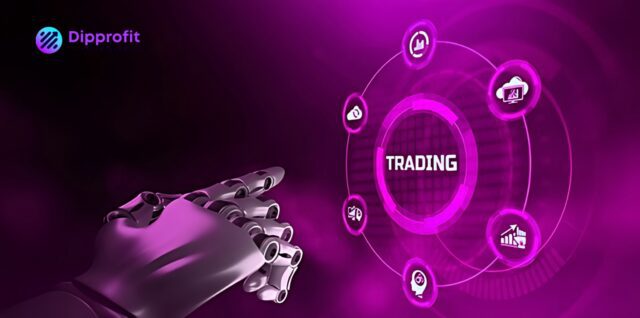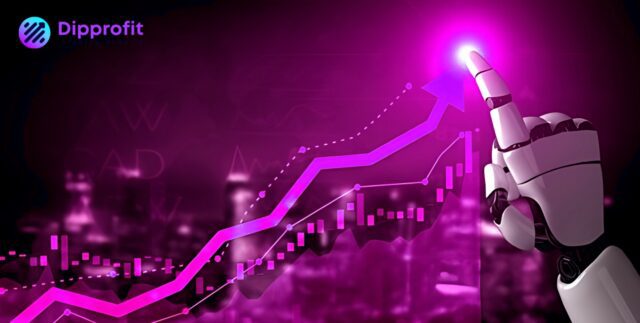Forex algo trading, also known as algorithmic trading, is a way to trade foreign currencies using automated computer programs.
Introduction to Forex Algo Trading

Forex algo trading works with programs that use math and stats to look at market data, like price changes and how much is being traded, to decide when to trade.
Forex algo trading has become more popular because it lets traders make trades quickly and accurately without needing to do it themselves.
Forex algo trading isn’t new and has been around for a while. But with better technology, like faster computers and the internet, it’s easier for regular people to use.
Now, lots of different traders, from individuals to big investment companies, use algorithmic trading.
One big benefit of algorithmic Forex trading is how fast it can make trades. The programs can look at the market and decide to trade in less than a second, much faster than a human trader. This speed is really important in Forex, where prices can change a lot in a short time.
Another benefit is that Forex algo trading doesn’t get influenced by emotions like humans do.
Sometimes, traders might make bad decisions because they’re scared or greedy. But algorithms make decisions based on rules, not feelings.
Algorithms can be used for many different trading strategies, from simple to complex. Some common strategies include following trends in the market, betting that prices will go back to average, and making trades to keep prices stable.
These strategies can use different types of algorithms, like ones that look at how prices are changing, or ones that learn from past data.
Automated Forex trading is a useful way for traders to automate their strategies and make trades quickly.
It has lots of benefits, like speed and accuracy, but there are also risks, like technical problems or using data that’s too specific to past markets.
Traders who want to use forex algo trading method should think carefully about these risks and make sure their programs can handle them.
See Also: Forex Trading for Beginners: A Comprehensive Guide
Types of Algorithms Used In Forex Algo Trading

Forex algo trading has changed the way people trade in the forex market. Traders can now use complex mathematical models and algorithms to automate their trading strategies, execute trades quickly, and take advantage of market opportunities.
There are different types of algorithms used in forex trading, each with its own characteristics and benefits.
1. Following Trends:
Trend-following algorithms are designed to identify and follow the direction of the market trend.
They use technical indicators like moving averages, MACD, and Bollinger Bands to determine the trend’s direction and enter trades accordingly. These algorithms work well in markets with clear trends but can struggle in sideways markets.
2. Mean Reversion:
Mean-reversion algorithms work on the idea that prices tend to return to their average over time.
These algorithms look for situations where prices have deviated significantly from their historical average and enter trades expecting prices to revert. They perform better in sideways markets but can struggle in trending markets.
3. Arbitrage:
Arbitrage algorithms take advantage of price differences between different markets or assets. They identify opportunities where the same asset is trading at different prices in different markets and execute trades to profit from the difference.
Arbitrage algorithms require fast execution and are commonly used by institutional traders.
4. High-Frequency Trading (HFT):
HFT algorithms execute a large number of trades at very high speeds. They use complex algorithms and fast data connections to exploit small price differences in the market. HFT algorithms need advanced technology and are often used by professional trading firms.
5. Sentiment Analysis:
Sentiment analysis algorithms analyze news, social media, and other sources to gauge market sentiment.
They help traders understand the market’s mood and make trading decisions based on sentiment. Sentiment analysis algorithms can be used with other types of algorithms to improve trading performance.
6. Machine Learning:
Machine learning algorithms use historical data to learn patterns and predict future price movements.
They can adapt to changing market conditions and improve their performance over time. Machine learning algorithms are becoming more popular in forex trading for developing accurate trading strategies.
These are the different types of algorithms used in forex algo trading, each with its own benefits. Whether you prefer following trends, mean reversion, arbitrage, or high-frequency trading, these algorithm that can help you achieve your trading goals.
See Also: Forex Hedging Strategy PDF Download for Beginners
Risk Management in Forex Algo Trading

Automated trading in the Forex market, also known as Forex algo trading, is becoming more popular and while Forex algo trading offers benefits like speed and efficiency, it also comes with risks.
Understanding the risks in algo trading is very important. The Forex market is volatile, meaning that currency prices can change rapidly.
Without proper risk management, traders could incur significant losses. That’s why it’s important to manage risks effectively when using algo trading.
There are several key principles to effective risk management in Forex algo trading:
- Position Sizing: This means deciding how much of your trading capital to risk on each trade. It’s important to only risk a small percentage of your capital on each trade to avoid large losses.
- Stop-Loss Orders: These are orders that automatically close a trade if the price reaches a certain level. They help limit losses and protect capital.
- Diversification: This involves spreading your risk by trading different currency pairs or using different trading strategies. Diversification can help reduce the impact of losses on your overall trading performance.
- Monitoring and Adjusting: It’s important to regularly monitor your trades and adjust your strategies based on market conditions. This can help you avoid large losses and improve your trading results.
There are also several tools you can use to help manage risk in Forex algo trading:
- Volatility-Based Stops: These adjust your stop-loss levels based on market volatility, helping you avoid exiting trades too early or too late.
- Trailing Stops: These automatically adjust your stop-loss levels as the trade moves in your favor, locking in profits while limiting losses.
- Risk-Reward Ratio: This involves aiming for a higher potential reward than the risk you are taking on each trade. A common ratio is 1:2, meaning you are aiming to make twice as much profit as the amount you are risking.
- Correlation Analysis: This involves analyzing the relationship between different currency pairs to avoid overexposure to correlated assets, which can help reduce risk.
Despite its importance, managing risk in algo trading can be challenging. Some common challenges include:
- Over-Optimization: This is when traders tweak their trading strategies too much to fit past data, which can lead to poor performance in live trading.
- Lack of Transparency: Some trading algorithms can be complex, making it difficult to understand and manage the risks associated with them.
- Technology Risks: There is always a risk of technical failures or glitches in trading algorithms, which can lead to losses if not addressed quickly.
Risk management is important for success in Forex algo trading. By understanding the risks involved and using the right tools and techniques, traders can minimize losses and improve their chances of success.
However, it’s important to remain adaptable and responsive to changing market conditions to effectively manage risks in algo trading.
Backtesting and Improving Your Trading Strategies

Having these Forex trading algorithms isn’t enough; traders need to test them thoroughly and make them better.
This process is called backtesting and optimization, and it’s very for making sure that trading strategies work well in real markets.
What is Backtesting?
Backtesting is like a simulation where traders test their trading strategies using past market data. They do this to see how well their strategies would have worked if they had used them in the past.
By doing this, traders can see if their strategies are good enough and if they need to change anything to make them better. It’s like a practice run before the real race.
To backtest a strategy, traders first need to define the rules of their strategy, like when to buy or sell, how much to risk, and other important things.
Then, they use historical market data to see how their strategy would have performed over a specific period. After that, they analyze the results to see if the strategy would have made money or not.
Why is Optimization Important?
While backtesting is useful, it’s important to remember that past performance doesn’t guarantee future success.
Markets change all the time, so a strategy that worked well in the past might not work well in the future. That’s where optimization comes in.
Optimization means making small changes to a strategy to make it work better in current market conditions.
Traders can adjust things like when to stop a trade, when to take profits, and other important factors to improve their strategy. By doing this regularly, traders can make sure that their strategies stay effective in changing markets.
Tips for Backtesting and Optimization
- Use Good Data: Make sure to use accurate historical data for backtesting. Bad data can lead to wrong results and bad strategies.
- Consider Market Conditions: When backtesting, think about things like how much it costs to make a trade, as these can affect your strategy’s performance.
- Optimize Regularly: Since markets change all the time, it’s important to regularly update your strategies to keep them working well.
- Try Different Timeframes: Test your strategy on different timeframes to see if it works well in different market conditions.
- Use with Other Strategies: While algorithms can be helpful, it’s also good to use them with other strategies to get the best results.
In summary, backtesting and optimization are important for Forex traders who want to do well in the market.
By testing their strategies and making them better, traders can increase their chances of making money and reduce their risks.
While past performance doesn’t guarantee future success, a well-tested and optimized strategy can give traders an advantage in the competitive Forex market
See Also: How to Trade Like a Pro Using SMC Trading Strategy
The Future of Forex Algo Trading

1. Artificial Intelligence (AI) and Machine Learning (ML)
AI and ML are changing Forex algo trading. They let algorithms look at lots of data and learn from it. This helps them spot patterns and trends that people might miss. AI and ML also help make models that can guess where the market is going.
2. Quantum Computing:
Quantum computing can make Forex algo trading much faster and more powerful. Quantum computers could look at market data and make trades in real time, much faster than now. While quantum computing is new, it could change how forex trading is done.
3. High-Frequency Trading (HFT):
HFT has been big in algo trading for a while. HFT lets algorithms make trades in milliseconds, taking advantage of small price changes. As tech gets better, HFT will likely become even more common.
4. Forex Algo Trading Platforms:
These platforms make it easier for traders to make and use their own trading algorithms. They offer tools that make algo trading simpler, giving more people access to it.
5. Regulatory Changes:
As Forex algo trading grows, regulators might make stricter rules to keep the market fair and protect investors. These rules could change how algorithms are made and used.
6. Integration of Alternative Data Sources:
Algorithms now look at more than just market data. They also use things like social media and weather data to make better guesses about the market.
7. Increased Focus on Risk Management:
As algorithms get better, traders are more focused on managing risk. They use algorithms to set rules for when to enter and exit trades, which helps manage risk better.
In the end, the future of Forex algo trading looks bright. As tech grows, traders can expect better algorithms, faster trades, and more use of AI and ML. While the future is not certain, Forex algo trading is here to stay, and those who use it smartly will do well in forex trading.
See Also: Forex Hedging Strategy for Beginners
Conclusion

In summary, Forex algo trading, also known as automated Forex trading, has changed how people trade the Forex market. It uses computer programs to make trading decisions based on specific rules.
This approach offers advantages like speed and accuracy, as well as the ability to trade without emotions influencing decisions.
However, there are risks involved, such as technical issues or relying too much on past data.
To manage these risks, traders need to use strategies like only risking a small percentage of their capital on each trade, setting stop-loss orders to limit losses, and diversifying their trades.
Different types of algorithms cater to various trading strategies, such as following trends or taking advantage of price differences between markets.
Traders should regularly test and improve their algorithms to ensure they work well in current market conditions.
Looking ahead, advancements in technology like AI and machine learning are expected to further enhance automated trading.
It’s important for traders to always learn about these developments to remain competitive in the Forex market.
Join our telegram community just in case you have not joined, we share lots of crypto market insights, give information on opportunities like this one and also make calls on tokens. You can also attend our AMA sessions on the telegram community, where we share other insights on other earning opportunities